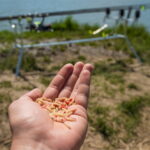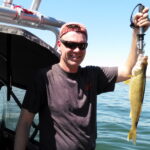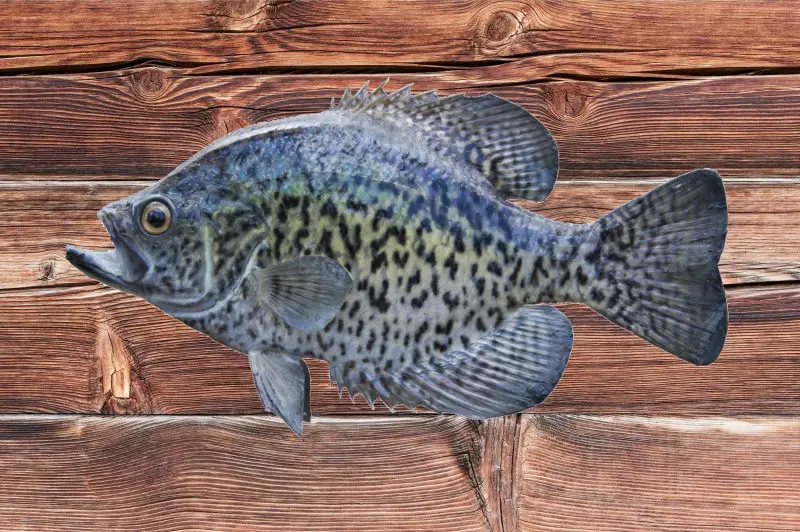The fact remains; anglers use live minnows as crappie baits since these fish enjoy eating the bait. Most crappie minnow vendors sell them by the scoop, pound, or gallon. As a concerned angler, you may want to know how many crappie minnows you’ll get in a pound to estimate your bait supply.
There are 40 to 72 large crappie minnows in a pound. On the other hand, the same pound of smaller minnows like the blunthead, mosquitofish, and fathead will have 130 to 360 minnows. Therefore, the number of minnows you get per pound varies depending on their type and size.
In the rest of this article, I’ll discuss how to choose minnows for crappie fishing. This article will help you know the factors to consider when selecting crappie minnows for the best results. Let’s get started!
Note: most links in this article are Amazon.com Affiliate links, see Affiliate Disclosure, thank you.
How To Choose Minnows for Crappie Fishing
It’s possible to think that buying minnows for crappie fishing is as easy as walking into the store, grabbing a scoop, and being on your way. If you’ve been doing that, then it’s the reason you’ve not been successful at catching crappies.
To be safer, you must know what to consider when choosing minnows for your type of fishing. Here are the crucial factors to consider:
Your Targeted Crappies
Crappies come in different shapes and sizes.
The crappie minnows you use for smaller species, like the black crappie, may not be suitable for the white or jumbo black crappie.
You’ll want to match the size of minnows with your targeted species’ mouth size. In this case, if you aim to catch smaller crappies, go for small-sized crappie minnows like:
- Fathead minnows
- Blunt head minnows
- Common minnows
- Mosquitofish minnows
On the other hand, if you intend to catch large crappie species, go for larger minnows like:
- Golden shiners
- Creek chubs
- Golden roaches
Size and Color of Minnows
The size and color of minnows play a vital role in making a catch.
Small-sized minnows will work well if you intend to fish in clear water since the fish can easily spot them. Moreover, the minnow must match the size of the crappie’s natural prey in that water body.
On the other hand, larger minnows are your go-to option if the water is murky. It’ll be easier for the crappies to spot such minnows in the dirty water.
Although crappies have a keen vision, you don’t want to leave anything to chance. Therefore, you should match the color of minnows with what crappies typically eat in that particular water body.
A helpful tip is to observe the surroundings and match your minnow’s color with its natural prey.
Alternatively, you can go for minnows with vibrant colors, like the golden shiners and rosy reds. These minnow species are prevalent in fishing since they attract fish regardless of water clarity and crappie species.
Minnows’ Condition
You don’t want to use sick or injured minnows as bait since they can transmit diseases to the crappies. It’s recommended to inspect the minnows for any signs of illness and injuries during your purchase.
Crappies are more attracted to live baits as these resemble what they eat in their natural habitat.
Healthy minnows are active and have clear eyes, smooth scales, and red gills.
It’s crucial to use the minnows as soon as possible after purchase before they die. However, with good care, you can preserve your minnows for the next fishing occasion.
Some tips for preserving minnows include:
- Keeping them in a cool and dark place.
- Using an aerator to ensure a constant oxygen supply.
- Frequently checking the water for any contamination or changes in pH levels.
- Storing them in a bait bucket.
The Frabill MIN-02-Life Aerated Bucket (available on Amazon.com) provides an easier way to keep your crappie minnows alive. The bucket has a tangle-free netting that prevents hook snags. It also has a capacity of 4.25 gallons (16.09 liters) to accommodate many crappie minnows.
Although minnows can survive for a few days without food, you should ensure a sufficient oxygen supply to keep them lively and healthy before using them as bait.
How To Hook a Minnow for Crappie Fishing
After choosing the right minnows for your crappie fishing, how do you get them to where your target is? This is where the hooking comes in.
It’s worth noting that hooking the minnow incorrectly can kill it immediately or let it off into the water. You don’t want this to happen since your goal is to use the minnow to lure the fish.
Before proceeding to the hooking stage, you must have the right hook. The hook should be thin with a long shank. Moreover, the hooking section should be one-third of the minnow’s body size.
If you’re wondering how to get the best fishing hooks, the Anmuka 2000pcs Fishing Hooks (available on Amazon.com) will work for you. The pack has a wide variety of hooks with different sizes to meet your different fishing needs. Thus, you don’t have to worry about buying an inappropriate hook.
Once you have the hook, you can proceed to hook the minnow. There are three ways to do that, as discussed below:
The Tail Hook Way
This is the preferred hooking way for line fishing.
The method involves inserting the hook through the minnow’s tail and pushing it until it protrudes through its back. The minnow will have more room to move and won’t get killed immediately by the hook.
The Lip Hook Way
This technique is suitable for larger crappies or when jigging, trolling, or casting. For this method, you should insert the hook through the minnow’s lower lip and push it past the upper lip. However, you should be careful not to pierce the minnow’s brain, as this will kill it instantly.
The Back Hook Way
This method is suitable for smaller crappies or when bobber fishing.
For this method, you insert the hook through the minnow’s back, just behind its dorsal fin, and push it until it protrudes on the other side. However, this technique can kill the minnow immediately if not done correctly. Therefore, you must be keen and not in a hurry.
Expert Tip: Crappies are clever fish and will not bite a minnow that smells like humans. Therefore, you must wash your hands in the water you want to fish in to remove any human scent. Washing your hands in the water gives them a smell similar to the fish’s habitat, increasing their chances of biting the bait.
Conclusion
Crappie minnows are your go-to option for crappie fishing since they are the perfect food for these fish.
However, not all minnows are suitable for use as bait. It’s essential to choose healthy and lively minnows before proceeding to the hooking process.
Going for smaller minnow species like fatheads is the best way to get more minnows per pound.





